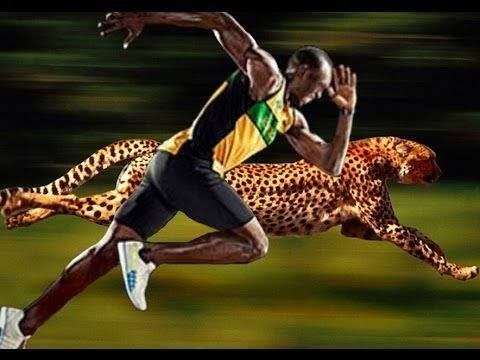
Incredible 3D Simulation Shows the Speed Difference Between Usain Bolt, the World’s Fastest Greyhound, and a Cheetah…
An awe-inspiring 3D simulation has vividly illustrated just how vast the speed gap is between the fastest human ever, the world’s swiftest greyhound, and nature’s ultimate sprinter—the cheetah. This visual comparison provides not just an entertaining spectacle but also a deeper understanding of how these different species are built for speed in their own unique ways.
The simulation begins with Usain Bolt, the Jamaican sprinting legend who set the world record in the 100-meter dash at 9.58 seconds in 2009. With a top recorded speed of approximately 27.8 mph (44.7 km/h), Bolt is unquestionably the fastest human in history. In the virtual race, he launches out of the blocks with his signature explosive power and fluid stride, yet within seconds, the limitations of human anatomy become evident when compared to his animal competitors.
Next to Bolt, the simulation places a greyhound, a breed of dog renowned for its incredible acceleration and racing capabilities. The fastest greyhounds can reach speeds up to 45 mph (72 km/h), nearly double that of the average human sprinter. As the race progresses, the greyhound quickly overtakes Bolt, using its aerodynamic body, long legs, and double-suspension gallop to gain an impressive lead. This canine marvel exemplifies evolutionary specialization for short bursts of speed—perfect for chasing down prey or winning races at the track.
But the true star of the simulation is the cheetah, nature’s speed king. Capable of reaching speeds of 60 to 70 mph (96 to 113 km/h) in just a few seconds, the cheetah absolutely dominates the race. Within moments, it rockets past both Bolt and the greyhound, creating a staggering visual contrast. The cheetah’s flexible spine, large nasal passages for increased oxygen intake, and powerful muscles all contribute to its elite sprinting ability. However, its speed is sustainable only for about 20–30 seconds due to the immense energy output and heat buildup.
The simulation does more than entertain—it educates. Through side-by-side comparisons, viewers can observe biomechanical differences: Bolt’s upright posture and rhythmic stride, the greyhound’s efficient gait and aerodynamic form, and the cheetah’s lightning-fast, fluid motion driven by evolutionary perfection. Each competitor is a marvel of design, optimized for peak performance within its species’ context.
In the end, while Bolt’s accomplishments are superhuman by human standards, they’re humbled when viewed through the lens of the animal kingdom’s fastest members. The simulation serves as a humbling reminder of the limitations of human speed, while also celebrating the incredible diversity of natural athleticism.
This digital showcase not only brings these comparisons to life in a visually stunning way but also fosters a greater appreciation for biomechanics, evolution, and the extraordinary adaptations that enable such phenomenal feats of speed across species.



Be the first to comment